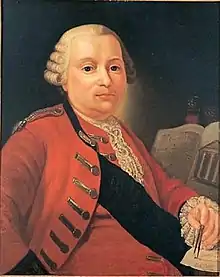
Ennemond Alexandre Petitot (1727-1801) was a French-born architect, mainly active in the Duchy of Parma.
Biography
He was born in Lyon in 1727, and by 1741, he had joined the studio of the architect Jacques Soufflot. From there he moved to study at the Académie d'Architecture in Paris. From there he moved under a grant to study architecture in Rome, and was there recruited by the prime minister Guillaume du Tillot to become the architect of the recently installed Bourbon Dukes in Parma.
His projects envisioning updating the Duchy along the lines of the Neoclassical style regnant in France. Many of his ambitious projects have either been reduced, razed, or remained unfinished. He also published series of engravings on various designs for architectural decoration. Among his architectural projects in the Duchy of Parma
- Venaria (Ducal hunting lodge) at Colorno (1753)
- Apartments (1755) and staircase for Ducal Palace of Colorno
- Sculptural Vases for Ducal Garden in Parma (1754), collaboration with the French sculptor Jean Baptiste Boudard (1710-1768) similar to those found in gardens at Palace of Versailles
- Loggia at theater at Ducal Palace of Parma with Boudard (1760)
- Facade of the church of San Pietro (1761-1762)
- Plans for boulevard-promenade (1763) along what is now Stradone Martiri della Liberta (at the time, he name had changed from the Stradone Farnese to Stradone Borbone); it was to be marked at the ends by two architectural units:
- At the Western end, ant the intersection with Strada Firini, a Colonna Borbone (Bourbon column), a 90-foot monumental free-standing doric column topped by Bourbon coat of arms
- At the Eastern end, the still-extant Casino del Caffè, now Casino Petitot designed as fashionable meeting spot, but now somewhat isolated in a traffic circle
- Ara Amicitiae monument (1769, since destroyed)[1]
- Designs for Biblioteca Palatina (1766), completed by Drugman
- Temple of Arcadia in the Gardens of Colorno (1769)
With the fall of minister du Tillot, and later the dislocations occurring Northern Italy after the French Revolution, the influence and scope of commissions for Petitot waned. He kept a teaching appointment at the Academy of Fine Arts of Parma.[2]
References
- ↑ In 1769, in the piazza in front of San Pietro, Petitot with collaboration of Jean Baptiste Boudard, completed a neoclassic monument to celebrate the visit of the Holy Roman Emperor Joseph II to Parma for the occasion of the marriage of the Duke Ferdinand with Maria Amalia, duches of Austria, sister of Joseph the II. (Source:Nuova descrizione della città di Parma, by Paolo Donati, Luigi Viganò, page 89. Titled the Ara Amicitiae (Altar of Friendship), the monument was a truncated column recalling the Ancient Roman Monument erected in Rome to celebrate the end of the wars in Germany. (Source: Biography of Boudard Archived 2016-03-04 at the Wayback Machine, from site of Basins in the Gardens of the Ducal Palace of Parma, with a model of the Ara Amicitiae.
- ↑ Fondazione Cariparma, biography prepared for exhibit in memory of the 200th anniversary of his death: E. A. Petitot nel bicentenario della morte: I disegni nella collezione della Fondazione Cariparma, held at Palazzo Bossi Bocchi, Parma, in 2002. He died in his house in Marore, where he had built a small private theater (teatrino).Beni Culturali, Emilia Romagna, Teatrino di villa Petitot, Marore.